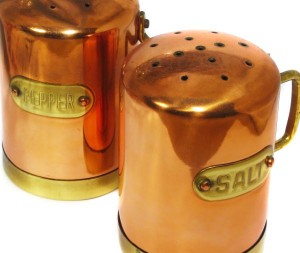Pass On the Salt for Weight Loss
Next time you sit down to a meal, pay attention to your eating routine. Do you automatically reach for the salt before you’ve even tasted your food? It’s not an  uncommon behavior among Americans – in a society where busy schedules barely allow for time to cook nutritious meals, we find ourselves reaching toward a fast-food window. Consumption of over-salted fries, cured meats, and canned soups high in sodium cause our bodies to crave salt all the more, and if you’re not careful you could eat your way to serious health problems.
uncommon behavior among Americans – in a society where busy schedules barely allow for time to cook nutritious meals, we find ourselves reaching toward a fast-food window. Consumption of over-salted fries, cured meats, and canned soups high in sodium cause our bodies to crave salt all the more, and if you’re not careful you could eat your way to serious health problems.
A recent article in The Health Journal reports that the USDA – as part of the current administration’s dedicated to improved health habits – plans to issue new reports on sodium intake. Presently the daily recommendation of salt is 2,300 milligrams, yet now that appears excessive. The maximum allowance is expected to drop as low as 1,500 milligrams. While this presents a more balanced look at health and nutrition options for Americans, however, many may find it a challenge to cut down on salty foods and that extra dash from the shaker to liven up a bland meal.
Indeed, too much salt in a diet can cause a variety of health problems, including high blood pressure, weight gain, and an increased risk in heart disease and strokes. It is also believed too much sodium in one’s diet may cause kidney damage and bone loss. If you are interested in losing weight, cutting back on this intake is a great way to start as you reduce the opportunity for water retention.
Some will ask, can it be done? With so many convenience foods packed with sodium, one will wonder how to escape the temptation. Through smart shopping and vigilance at trips to restaurants, however, you’ll find it is possible to reduce how much you eat so your sodium levels decrease. Here are a few tips to get you started.
1) Put down the salt shaker. Though it’s estimated the average person gets only ten percent of his salt through that occasional sprinkle, it’s ten percent more than you really need! If you want to liven up bland food, try a seasoning that is low in sodium.
2) Watch the extras. Yes, a healthy salad with a lean cut of meat looks yummy, but if you bathe them in dressings and sauces, watch out. You’re adding extra salt to your food. Take care not to indulge too much in them – try your food au naturel and enjoy the flavor.
3) Drink more water. Soft drinks and coffees do have some amount of sodium, so watch what you drink. Besides, you should be drinking more water anyway.
4) Read labels. For every item you consider adding to your shopping cart, check the back. While you’re more likely to note calories and fat grams, you’ll be surprised to know even so-called “diet” items are very salty. Pre-packaged dinners and frozen pizza, for two, are major offenders. Look for low to no sodium items when you shop.
With a lower level of salt in your system, you might find your health and energy improve. You may retain less water and make it easier to lose weight. All it takes is a reduction in intake and watching what you put in your mouth, and on your food.
Kathryn Lively writes about Hampton Roads health issues.

